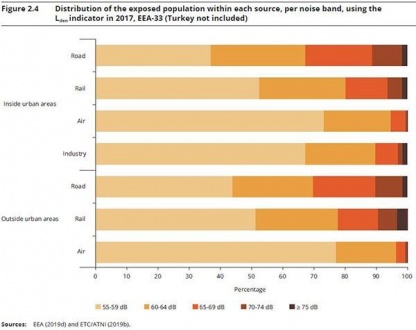Exposure to noise in Europe: the 2020 EEA Report
 The 2020 report repeats the indications of its predecessor. Moreover, it recommends the use of homogeneous detection systems and encourages the implementation of further mitigation actions to expand the benefit not only to humans but also to animals, and the quality of air.
The 2020 report repeats the indications of its predecessor. Moreover, it recommends the use of homogeneous detection systems and encourages the implementation of further mitigation actions to expand the benefit not only to humans but also to animals, and the quality of air.
Exposure to noise in Europe: the 2020 EEA Report
The 2020 report repeats the indications of its predecessor. Moreover, it recommends the use of homogeneous detection systems and encourages the implementation of further mitigation actions to expand the benefit not only to humans but also to animals, and the quality of air.
The new report of the European Environment Agency (EEA) confirms that noise exposition has an important effect on people’s mental and physical wellbeing. It has been estimated that noise pollution affects at least 20% of the European population living in urban areas where the level of traffic noise is harmful for people’s health. In Europe, about 113 million people are exposed to long-term traffic noise levels both during day and night, for a value of at least 55 decibels (dB) or higher. On top of these, the following are to be added: 22 million people are exposed to high noise levels deriving from railway traffic; 4 million people are exposed to air traffic noise; whilst less than 1 million are the people exposed to high noise levels generated by industrial estates. In general, the number of people exposed to noise sources has been stable since 2012; however, it has been predicted that noise pollution will increase due to population growth in urban centres and the subsequent increase of people’s mobility needs.
According to the World Health Organization (WHO), a prolonged exposition to noise pollution is associated to the risk of the occurrence of negative effects for people’s physiological and psychological health. In urban areas, over 50% of the measures taken for managing noise reduction has been focused on the sources that cause it. For this reason, sound-absorbing asphalts, electric mobility – both private and public - or micro mobility (bicycles or scooters) have been favoured.
The noise external to urban areas is represented as follows: 52% railway traffic; 70% air traffic; 39% is road traffic, both on roads and motorways.
The effects deriving from extended exposure to noise pollution cause chronical sleep disorders to 6.5 million people. There have been 48,000 cases of ischemic heart disease and 12,000 are the premature deaths recorded. According to EEA’s report estimates, 12,500 European students suffer from learning disorders deriving from air traffic noise.
With the aim of offering the urban population tools to reduce the incidence of noise and its deriving disorders, Public Administrations have identified a possible solution in the green, silent areas outside urban centres. However, the creation of “silent areas” is limited by the fact that they cannot be easily accessed by the vast majority of citizens. For this reason, specific criteria and requisites are being studied to better identify and improve accessibility. The report mentions also the effects of noise pollution on animals, by altering their physiology and behaviour, highlighting a reduction in their reproduction, an increase in their mortality, and a mutation of the migration routes - to which a reduction in numbers of the population follows.

The new 2020 report has developed a mapping method of homogeneous noise in order to compare noise maps among European countries more easily. These maps are necessary to gather data that can, so, be compared more easily than in the past.
Moreover, the report intends incentivising the European legislation to make adjustments and reconfigure some devices of railway transport, thus allowing the predisposition of enhanced silent braking units on locomotives and cars. Moreover, it allows for the installation of noise dispersion devices based on what stated in the “European Noise Directive” (END).
In addition to this, the report highlights the changing of habits and the acceptance of shared electric micro mobility vehicles among the public. It does not describe an increase in the awareness and a changing in behaviour of people towards a greater use of means of transport with reduced or no noise intensity, thus inducing the Public Administrations to regulate their use and management.
The Report helps to keep track of the progress made and, at the same time, to relaunch the objectives set in the Seventh Environment Action Programme (7th-EAP), and to show new response actions for the next projects related to noise pollution. To face this environmental stress factor, the 7th-EAP establishes a meaningful reduction of the levels of noise pollution, thus getting close to the levels suggested by the WHO. To reach this objective more easily, the 7th-EAP recommends to update EU’s policies on noise pollution to align them to the results of the latest scientific evidence, there included the improvements deriving from city design.
Source: ARPAT




